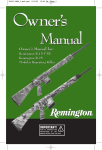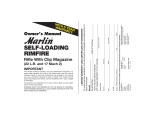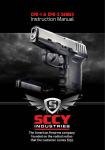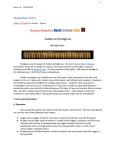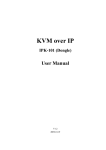Download Owners Manual v2
Transcript
Owner’s Manual Owner’s Manual for: Remington Model Five Bolt-Action Rimfire Rifle PAGE 2 ........THE TEN COMMANDMENTS OF FIREARM SAFETY IMPORTANT! PAGE 5 ........IMPORTANT PARTS OF THE FIREARM READ ALL WARNINGS AND INSTRUCTIONS IN THIS MANUAL BEFORE USING THIS RIFLE PAGE 10........OPERATING INSTRUCTIONS PAGE 14........CLEANING INSTRUCTIONS PAGE 15 ......PARTS AND SERVICE 1 Safety is Critical to Performance. A superbly crafted gun is only as good as the hands that hold it. You can never be too careful. Shooting accidents are often caused by careless oversights such as failing to control the direction of the muzzle, failing to fully engage the safety, leaving ammunition in the chamber or using improper loads. These oversights can result in the destruction of life, limb or property. There’s no calling back a bullet once it’s been fired, so it’s critical that you know the principles of safe gun handling and storage before you ever take your new Remington firearm out of the box. The proper use and performance of your firearm depends on correct assembly and maintenance, so it’s critical that you familiarize yourself with the information in this instruction book. Even if you’re a veteran shooter with a collection of Remington firearms, take the time to read this literature. Not all firearms are the same. That means the first step in safe handling is to learn the features and requirements of your new Remington. THE TEN COMMANDMENTS OF FIREARM SAFETY With the privilege of owning a firearm comes the responsibility to use it safely. You must understand and follow the Ten Commandments of Firearms Safety at all times. These time-honored safety rules apply to your ownership and handling of any firearm. They must govern your actions whenever and wherever you are involved with firearms . . . in the field, on the range, or in your home. Commit these Ten Commandments to your memory. 1st COMMANDMENT Always Keep the Muzzle Pointed in a Safe Direction. This is the most important gun safety rule. A safe direction is one in which an accidental discharge will not cause injury to yourself or others. Never allow your gun to point at anything you don’t intend to shoot. Be especially careful when you’re loading or unloading. Treat every gun as if it were loaded. And make it a habit to know where the muzzle is pointed at all times, even when your firearm is unloaded. No one will be injured by an accidental discharge if you keep your firearm pointed in a safe direction. It’s as simple as that. 2nd COMMANDMENT Firearms Should be Unloaded When Not in Use and Secured from Unauthorized Use. Load your firearm only when you are in the field or on the range and ready to shoot. Unload your firearm as soon as you are finished shooting. Never bring a loaded firearm into your camp, home or vehicle. Unloading means unloading both the chamber and the magazine. Before handling a firearm or passing it on to someone else, visually check the chamber, receiver, and magazine to make sure there is no ammunition anywhere in the firearm. Never assume a firearm is unloaded, and never take someone’s word for it - look for yourself. When you are finished shooting and have completely unloaded the firearm, leave its action open. Whenever you are carrying a loaded firearm in the field, you must unload it before crossing a fence, climbing into a tree stand or blind or in any other situation where you may not be able to fully control the firearm. Never pull or push a loaded firearm toward yourself or another person. Store your firearms unloaded in a secure place where unauthorized persons cannot gain access to them. Store firearms and ammunition separately. If you use an external security device such as a cable lock or trigger lock, you must still keep the firearm unloaded when locked. Whether you utilize a locked gun safe or external locking device, it is your responsibility to make sure that children and other unauthorized persons cannot gain access to your firearm and ammunition. 2 3rd COMMANDMENT Never Rely on Your Firearm’s Safety Mechanism to Justify Careless Handling. If your firearm is equipped with a manual safety mechanism, do not rely on the safety as an excuse for improper or careless handling of the firearm. The safety mechanism is merely a supplement to your proper handling of the firearm. The safety mechanism may be broken or altered. Even if you think you have previously engaged the safety in the “safe” position, it may have been inadvertently disengaged without your knowledge while being carried. Never assume that the safety mechanism is engaged in the “safe” position. Your assumption may be wrong or mistaken. Treat your firearms safety mechanism like you would treat any other mechanical device - as something that could break or fail. Not all safety mechanisms operate in the same manner. Before using any firearm, know and understand precisely how the safety mechanism on that particular firearm operates. Never pull the trigger when the safety mechanism is in the “safe” position, and keep your fingers away from the trigger while loading, unloading, and engaging or disengaging the safety mechanism. 4th COMMANDMENT Know Your Target and What’s Beyond It. Never fire a shot unless you know exactly where the shot is going and what it will strike. Bullets and shot can travel great distances with deadly velocity. When hunting game, never fire at a sound, a movement or a patch of color - an impulsive shot can have tragic consequences. A fellow hunter in camouflage may be mistaken for game by an impulsive shooter. In addition to being sure of your target, you must know what lies beyond the target. In other words, make sure of your backstop. Also, beware of ricochets - never shoot at water or a hard surface. 5th COMMANDMENT Use Proper Ammunition. Every firearm is designed to use only a specified caliber, gauge or length of ammunition. Use of the wrong ammunition can cause serious personal injury or death. It is your responsibility to make sure the ammunition exactly matches the specifications for your firearm. Use of improperly reloaded ammunition can also be dangerous. Firearms are designed, manufactured, and proof-tested to specified industry standards. Hand-loaded or reloaded ammunition that deviates, either intentionally or accidentally, from specified loadings can be extremely hazardous. It is strongly recommended, therefore, that you use only factory ammunition from a reputable ammunition manufacturer. If you do reload, you have assumed the risks and responsibilities of an ammunition manufacturer. 6th COMMANDMENT If Your Firearm Fails to Fire When You Pull the Trigger, Handle With Care. If a chambered round of ammunition does not fire when you pull the trigger, stop and keep the muzzle pointed in a safe direction. Treat your firearm as if it could still discharge. Keep your face away from the breech. Slowly and carefully open the action, return the safety mechanism to the “safe” position, and unload the cartridge from the chamber. Dispose of the cartridge safely. If your firearm repeatedly fails to fire when you pull the trigger, take your firearm and ammunition to a competent gunsmith or return the firearm to the manufacturer for inspection. 3 7th COMMANDMENT Always Wear Eye and Ear Protection. Wear protective shooting glasses and hearing protection when shooting. Be sure to wear eye protection when disassembling or cleaning a firearm to protect your eyes from springs and other tensioned parts. Continued exposure to shooting noise can permanently damage your hearing. 8th COMMANDMENT Be Sure the Barrel is Clear of Obstructions Before Shooting. With your firearm completely unloaded, open the action and make sure there are no obstructions or debris in the barrel. Even a small obstruction such as snow or mud in the barrel can cause the barrel or receiver to burst when the next round is fired. Use a cleaning rod to remove obstructions and residues from the barrel. If the firing noise or recoil seems weak, stop and completely unload your firearm to check for obstructions before firing another shot. NEVER try to shoot out an obstruction by loading and firing another round of ammunition. 9th COMMANDMENT Never Alter or Modify Your Firearm and Have it Cleaned and Serviced Regularly. Your firearm has been carefully designed and manufactured to operate according to certain factory specifications. NEVER alter or modify your firearm, especially its trigger or safety mechanism, in any way. Such alterations or modifications can adversely affect the safe operation of your firearm, endangering you and those around you. As with any mechanical device, the parts of a firearm are subject to wear or breakage. To assure optimum safety and performance, your firearm must be maintained and serviced on a regular basis. Only a competent gunsmith or a Remington Authorized Service Center should service or repair your firearm. Proper cleaning and lubrication are also important to maintain the safe and proper functioning of your firearm. Follow the cleaning and lubrication instructions set forth in the owner’s manual for your firearm. NEVER attempt to clean or lubricate a loaded firearm. 10th COMMANDMENT Learn How Your Firearm Operates. Not all firearms are alike. Before you use any firearm for the first time, you must become totally familiar with how that firearm operates. When you receive a new firearm, read and understand the owner’s manual before assembling the firearm for the first time. If you acquire a used firearm, request an owner’s manual and have the rifle inspected by a competent gunsmith to determine whether it is in good working order. If you do not have an owner’s manual, contact the manufacturer to obtain one. If you are selling or trading your firearm to someone else, be sure to transfer the owner’s manual to the new owner. 4 Important Warnings LEAD EXPOSURE WARNING Discharging firearms in poorly ventilated areas, cleaning firearms or handling ammunition may result in exposure to lead, a substance known to cause birth defects, reproductive harm, cancer and other serious physical injury. Have adequate ventilation at all times. Wash hands thoroughly after exposure. SHOOT SOBER! Guns and alcohol or drugs don’t mix. Never consume anything that would even mildly impair your judgement or physical coordination while handling a firearm. WARNING Failure to follow any of these safety rules may cause personal injury or death to the shooter or bystander and damage to property. Do not use a firearm until you fully understand and practice the Ten Commandments of Firearm Safety. If you have any questions about the safe use of a Remington firearm, write to us at Remington Arms Company, Inc., Consumer Service, P.O. Box 700, Madison, NC 27025-0700, or call us at 1-800-243-9700. Important Parts of Your Rifle Congratulations on your choice of a Remington® Model Five bolt-action rimfire rifle. With proper care and if used in accordance with the Ten Commandments of Firearm’s Safety and this owner’s manual, your rifle should give you many years of dependable use and enjoyment. The following picture depicts the main parts of a Model Five rimfire bolt-action rifle and will aid in understanding the instructions in this Owner’s Manual. BOLT-ACTION MID SIGHT SAFETY MECHANISM FRONT SIGHT STOCK MUZZLE BARREL MAGAZINE CLIP TRIGGER SLING STUD TRIGGER GUARD SLING STUD This picture shows the main parts of a Remington Model Five bolt-action rifle. The picture will aid in understanding the instructions in this book. 5 The Safety Mechanism The safety mechanism is located on the right sight of the receiver just behind the bolt handle. (See Picture 1). Picture 1 Note: The safety mechanism cannot be engaged in the “safe” position unless and until the rifle is cocked. To engage the safety mechanism in the “safe” position, pull the safety to its most rearward position, covering the red indicator dot on the stock. (See Picture 2). Picture 2 “SAFE” Position 6 The Safety Mechanism (cont’d) To place the safety mechanism in the “fire” position, push the safety fully forward, exposing the red indicator dot on the stock. The rifle is now ready to fire by pulling the trigger. (See Picture 3). Picture 3 “FIRE” Position WARNING The firearm will fire when the trigger is pulled and the safety mechanism is in the “FIRE” position if the bolt is installed in the receiver. The Locking Device This firearm was originally sold with a key-operated locking device to assist the owner in protecting against unauthorized use. These are storage, locking devices and the firearm should be unloaded when stored or not in use. Using a locking device cannot substitute securing your firearm and ammunition in a separate, locking location. See the 2nd Commandment of firearms safety. The locking device provided does not eliminate the need for safe gun handling and storage, including keeping this and every gun unloaded and locked in a secure place when not in use. Read and follow these and other safety rules in this instruction book. Failure to read, understand and obey these rules can result in serious personal injury or death. See the ten commandments of firearms safety on pages 2, 3, and 4. Keep your locking device engaged when your firearm is not in use. Keep the keys in a secure place, inaccessible to others. DO NOT leave your keys or any ammunition with your firearm, which should be kept unloaded and locked in a safe place. 7 External Control Parts THE BOLT: The bolt has been packaged separately in the shipping carton. The bolt should be cleaned and lightly oiled before its initial use. You must become familiar with installing and removing the bolt properly. NEVER attempt to install or remove the bolt on a loaded firearm. Completely unload the firearm (empty chamber and magazine) before installing or removing the bolt. WARNING Before installing or removing the bolt, visually inspect the chamber and receiver to make sure the chamber and magazine are completely empty. Never attempt to install or remove the bolt with a loaded firearm. Installation 1. After inspecting your firearm to insure it is not loaded, move the Safety Mechanism to the “FIRE” position. 2. Holding the bolt handle with your right hand, orient the bolt to the receiver with the bolt handle raised. (See Picture 4). Picture 4 3. Grasping the pistol grip of the stock with your left hand, pull the trigger and hold it to the rear. (See Picture 5). Picturee 5 4. Slide the bolt forward until it is fully in the receiver. (See Picture 6). Picture 6 8 External Control Parts (cont’d) Installation (cont’d) 5. Lower the bolt handle to the fully down position. (See Picture 7). 6. Release the trigger. (See Picture 8). The bolt is now installed in the receiver. Picture 7 7. Raise the bolt handle and move the bolt to the rear of the receiver. 8. Return the Safety Mechanism to the “SAFE” position. Picture 8 Removal WARNING Before installing or removing the bolt, visually inspect the chamber and receiver to make sure the chamber and magazine are completely empty. Never attempt to install or remove the bolt with a loaded firearm. 1. After inspecting your firearm to insure it is not loaded, move the Safety Mechanism to the “FIRE” position 2. Raise the bolt handle with your right hand. 3. With the bolt handle fully raised, use your left hand to pull the trigger and hold it to the rear. (See Picture 9). Picture 9 4. Keeping the trigger pulled fully to the rear, pull the bolt to the rear and out the receiver. (See Picture 10). Picture 10 WARNING The bolt has been fitted at the factory to assure proper head space when used with this particular rifle. Never interchange bolts from one rifle to another as this may affect head space leading to a potentially hazardous situation. If your bolt is damaged or lost, return your rifle to the factory for replacement with a properly fitted bolt. 9 External Control Parts (cont’d)) THE TRIGGER: The trigger mechanism has been preset at the factory. Never alter or modify the trigger or firing mechanism. (See Ninth Commandment of Firearms Safety.) THE BARREL: Some of the metal parts of your rifle have had a rust preventative compound applied at the factory to protect the metal during shipment. Before shooting your rifle for the first time, you must clean the anti-rust compound from the barrel, receiver, breech bolt mechanism, and the action/chamber areas. To clean the barrel, refer to the Cleaning Instructions in this Owner’s Manual. Operating Instructions Model Five rifles are manufactured with a 5-round detachable box magazine. Before loading your rifle for the first time, make sure (1) you have read and understand all of the warnings and instructions in this Owner’s Manual, and (2) you have removed all grease and oil from the barrel and chamber and any obstructions from the barrel. Loading the Rifle 1. Keep the rifle pointed in a safe direction throughout the loading process. 2. Make sure the safety mechanism is engaged in the “safe” position. 3. Lift the bolt handle and pull the bolt all the way to the rear. 4. Depress the magazine latch in front of the trigger guard, allowing the magazine to be pulled out of the bottom of the receiver. (See Picture 11). Picture 11 5. Place a cartridge on top of the follower of the magazine and press down on the cartridge until it is retained in the magazine. Carefully position the cartridge so that its base is flush with the rear of the magazine. (See Picture 12). Picture 12 10 Operating Instructions (cont’d) LOADING THE RIFLE: (cont’d) 6. Place each successive cartridge in the magazine as described in Step 4, until the magazine is full. 7. With the bolt still open and to the rear, insert one round directly into the chamber. (See Picture 13). Picture 13 8. Close and lower the bolt. (See Picture 14). The rifle now has a live round in the chamber. Picture 14 9. Insert the magazine back into the magazine well of the receiver until it is retained by the magazine latch. (See Picture 15). 10. Your rifle is now in the ready-to-fire condition, loaded with a round in the chamber and a full magazine. Picture 15 Note: SINGLE LOADING: Your rifle may be loaded with a single round in the chamber and no cartridges in the detachable box magazine. To single-load the rifle, simply skip Steps 5, 6, and 9 above. LOADING THE MAGAZINE ONLY: Your rifle may be loaded with no round in the chamber and a full magazine. To accomplish this type of loading, follow Steps 1 through 6 above. Then close the bolt on an empty chamber before inserting the loaded magazine into the receiver. The bolt will now be closed over an empty chamber. A round may subsequently be loaded into the chamber for firing by opening and fully retracting the bolt and then closing the bolt, stripping off the top cartridge from the magazine into the chamber. WARNING Your rifle may fire a chambered round even if the magazine has been removed from the rifle. Never assume the rifle is unloaded merely because you have removed the magazine. 11 Operating Instructions (cont’d) Once a cartridge has been loaded into the chamber, the rifle is ready to be fired. FIRING THE RIFLE: 1. Aim the rifle at your intended target, with the butt of the rifle planted firmly against your shoulder. 2. Keeping your fingers away from the trigger, push the manual safety forward to the “fire” position. 3. Put your trigger finger on the trigger and slowly squeeze or pull the trigger to fire the rifle. Note: Unless you intend to fire another shot right away, leave the bolt closed over the fired cartridge. 4. To extract and eject the fired cartridge case, lift the bolt handle and pull the bolt all the way to the rear. 5. Closing the bolt will then chamber the next cartridge from the magazine. Unless you intend to fire an immediate next shot, pull the safety fully to the rear to the “safe” position. Your rifle is now loaded with another round in the chamber. 12 Unloading Your Rifle 1. Keep the muzzle pointed in a safe direction and your fingers away from the trigger throughout the unloading process. 2. Make sure the safety is engaged in the “safe” position. 3. Depress the magazine latch in front of the trigger guard, allowing the magazine to be pulled out of the bottom of the receiver. (See Picture 16). Picture 16 WARNING At this stage in the unloading process, your rifle still has a live round in the chamber which may be fired even though the magazine has been removed. Never assume your rifle cannot fire simply because the magazine has been removed. 4. Lift the bolt handle and pull the bolt fully to the rear to remove the cartridge from the chamber. (See Picture 17). Picture 17 5. With the bolt open (fully to the rear), look into the chamber and magazine well to make sure all cartridges have been removed from the rifle 6. Empty the cartridges from the box magazine in a reverse manner from the loading instructions. You may store the empty magazine separately or reinsert it into the rifle. 7. With the bolt still open, visually recheck the chamber and magazine well to make sure the rifle is completely unloaded. 13 Cleaning Instructions WARNING NEVER attempt to clean a loaded firearm. Make sure the rifle is completely unloaded (chamber and magazine empty) before cleaning. CLEANING THE BARREL: 1. Remove the bolt from the rifle. (See Page 9). 2. Select a cleaning rod and brush of the appropriate caliber for your rifle. 3. Soak the cleaning brush with a quality gun cleaning solvent (such as Remington BriteBore® solvent or Remington Bore Cleaner). 4. Push the cleaning rod and brush through the entire length of the barrel several times. 5. Remove the brush from the cleaning rod and attach a dry cleaning patch to the patch attachment. 6. Push the rod and dry patch through the entire length of the barrel several times. Repeat with another dry patch until the patch is no longer dirty. 7. Put a patch saturated with a quality gun oil (such as Rem Oil®) on the rod tip. 8. Push the oiled patch through the barrel several times. 9. Remove the oiled patch from the rod tip, and insert another dry patch. 10. Push the dry patch through the barrel several times to remove any excess oil from the barrel. 11. When you have finished cleaning the interior of the barrel, visually check the bore to make sure no patches or other obstructions remain in the barrel. 12. Apply a thin coat of gun oil to the outside of the barrel with a soft clean cloth. CLEANING THE ACTION: 1. Use a patch or soft clean cloth to clean powder residues and any other foreign materials from the bolt and receiver surfaces. To clean congealed lubricants or other hard to remove deposits, use a quality action cleaner (such as Rem Action Cleaner). (See Picture 18). 2. Apply a light film of quality gun oil (such as Rem Oil®) along the bolt and receiver surfaces. Avoid applying too much lubricant - - only a light film is necessary. Picture 18 WARNING Never attempt to take your rifle apart further than as set forth in the Owner’s Manual. If further cleaning, service or repairs are needed, take your rifle to a competent gunsmith or return to Remington for service. 14 PARTS AND SERVICE To Order Parts ALL PARTS ARE SUBJECT TO A $10.00 CHARGE FOR SHIPPING AND HANDLING. Some parts are restricted and may only be installed by returning the rifle to us. When ordering parts, please state the Model, Gauge, Serial Number, and Finish Color. For parts information, call (321) 639-1432. Service To obtain information about returning your rifle for service or repairs, call (321) 639-1432. One Year Limited Warranty This rifle is warranted to the original retail customer for one year from the date of retail purchase against defects in material and workmanship. All parts and labor or replacement at our option are covered. The wood stock is not covered by the one year warranty. The warranty on the wood stock is 60 days and is limited to the original retail customer and extends 60 days from the date of retail purchase and covers only manufactured and material defects. Transportation to and from our repair facilities, government fees, damage caused by failure to perform normal maintenance, sales outside the United States, damage caused by use of high velocity, high pressure, reloaded or other nonstandard ammunition, or by any unauthorized repair, modification, misuse, abuse or alteration of the rifle is not covered by this Limited Warranty. Implied Warranty ANY IMPLIED WARRANTIES, INCLUDING THE IMPLIED WARRANTIES OF MERCHANT ABILITY AND FITNESS FOR A PARTICULAR PURPOSE, ARE LIMITED IN DURATION TO ONE YEAR FROM THE DATE OF ORIGINAL RETAIL PURCHASE. SOME STATES DO NOT ALLOW LIMITATIONS ON HOW LONG AN IMPLIED WARRANTY LASTS, SO THE ABOVE LIMITATION MAY NOT APPLY TO YOU. To the extent any provision of this warranty is prohibited by federal, state, or municipal law, which cannot be preempted, it shall not be applicable. This warranty gives you specific legal rights, and you may also have other rights which may vary from state to state. To obtain warranty service, send your rifle with proof of retail purchase, freight prepaid to: REMINGTON I.S.P. c/o USSG 402 Richard Road Rockledge, FL 32955 NOTICE: It is illegal to ship a firearm with ammunition in the firearm or in the same packaging. Firearms and ammunition must be shipped separately. For information about shipping ammunition, call (321) 639-1432. 15 PARTS LIST Model 5 Rimfire Bolt-Action Exploded View 1 2 3 4 5 7 8 9 10 11 12 13 14 15 16 17 18 19 20 21 22 23 24 25 26 Magazine bottom plate Magazine bottom plate Magazine box Magazine bottom lock piece Follower Receiver Bolt body Barrel Bolt handle Extractor, left Extractor, right Trigger holder Trigger Safety Trigger screw Ejector Magazine carrier Magazine holder Spring holder Cover Ejector securing pin Safety lever Plug Firing pin Magazine holder axle 27 28 29 30 31 32 33 34 35 36 37 38 39 40 41 42 43 44 45 46 47 48 49 50 51 16 Abutment screw Regulating screw Extractor axle Trigger spring screw Magazine holder spring Screw Firing pin spring Magazine holder spring Stock Trigger guard Magazine holder button Screw Distance bushing Carrier Front sight base Screw Front sight Rear sight base Base screw Rear sight carrier Plate carrier Rear sight plate Rear sight spring Rear sight axle Plate screw WARNING Children are attracted to and can operate firearms that can cause severe injuries or death. Prevent child access by always keeping guns locked away and unloaded when not in use. If you keep a loaded firearm where a child obtains and improperly uses it, you may be fined or sent to prison. ADVERTENCIA A los ninos los atroen las armaside de fuego y los pueden hacer funcionar. Ellos pueden causarses lesiones graves y la muerte. Evite que los ninos tengon acceso a los armas de fuego guardandolas siempre con llave y descargadas cuando no las este utilizando. Si usted tiene un arma de fuego cargado en un lugar en que un nono tiene acceso a ella y la usa indebidamente. Le pueden dar una multa a enviarlo a la carcel. REMINGTON I.S.P. c/o USSG 411 Hawk Street Rockledge, FL 32955 Manufacturer: ZASTAVA ORUZJE D.P. 4 Trg topolivaca 34000 Kragujevac Serbia & Montenegro 17 Remington is a trademark registered in the United States Patent and Trademark Office by Remington Arms Company, Inc.
























